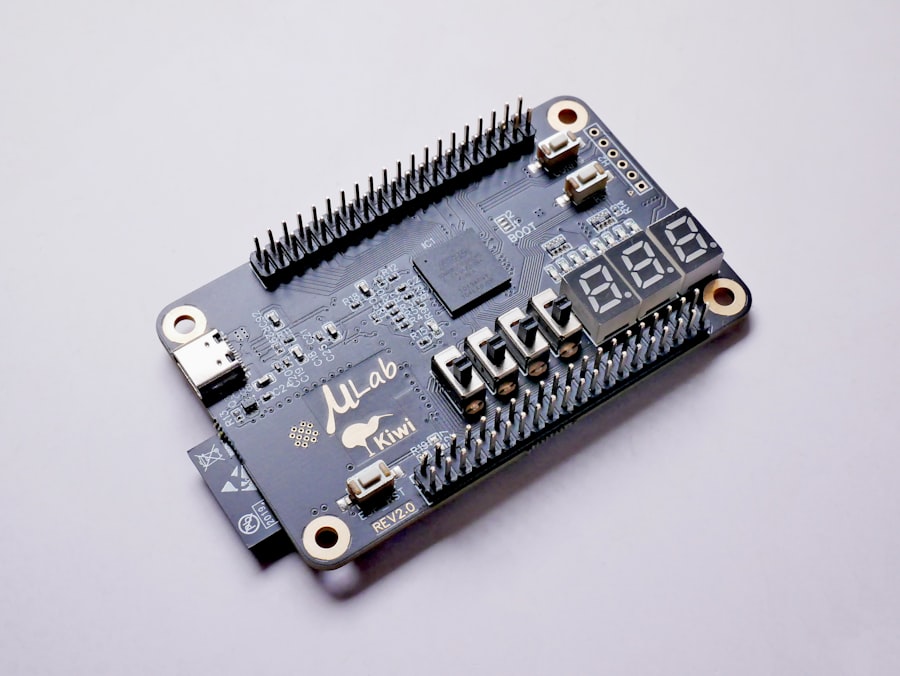Field-Programmable Gate Arrays (FPGAs) represent a significant advancement in the realm of digital circuit design and implementation. Unlike traditional Application-Specific Integrated Circuits (ASICs), which are hardwired for specific tasks, FPGAs offer a unique flexibility that allows engineers to configure the hardware according to their specific needs. This reconfigurability is achieved through a matrix of programmable logic blocks and interconnects, enabling users to tailor the architecture for various applications.
The ability to modify the hardware post-manufacturing makes FPGAs particularly appealing for industries that require rapid prototyping and iterative design processes. The evolution of FPGA technology has been marked by continuous improvements in performance, power efficiency, and ease of use. Modern FPGAs are equipped with advanced features such as high-speed transceivers, embedded processors, and extensive memory resources.
These enhancements have expanded their applicability beyond traditional domains, allowing them to play a pivotal role in high-performance computing (HPC). As the demand for computational power grows, particularly in fields like artificial intelligence, data analytics, and scientific simulations, FPGAs have emerged as a viable solution to meet these challenges.
Key Takeaways
- FPGA technology offers customizable hardware acceleration for enhanced computing performance.
- FPGAs provide significant benefits in speed, energy efficiency, and parallel processing capabilities.
- They are widely applied in fields like scientific simulations, data analytics, and machine learning.
- Implementing FPGAs requires addressing challenges such as design complexity and integration issues.
- Best practices and case studies demonstrate effective strategies and future potential of FPGA in HPC.
Understanding the Benefits of FPGA for High-Performance Computing
One of the primary advantages of using FPGAs in high-performance computing is their ability to achieve parallel processing at an unprecedented scale. Unlike conventional CPUs, which typically execute instructions sequentially, FPGAs can perform multiple operations simultaneously. This parallelism is particularly beneficial for applications that require extensive data processing, such as image and signal processing, where tasks can be distributed across numerous logic blocks within the FPGThe result is a significant reduction in processing time and an increase in throughput.
Moreover, FPGAs offer a high degree of customization that allows developers to optimize their designs for specific workloads. This optimization can lead to improved performance per watt, making FPGAs an energy-efficient alternative to traditional computing architectures. For instance, in machine learning applications, FPGAs can be programmed to implement specific algorithms directly in hardware, reducing the overhead associated with software execution on general-purpose processors.
This tailored approach not only enhances performance but also minimizes latency, which is critical in real-time applications.
Exploring the Applications of FPGA in High-Performance Computing

FPGAs have found a diverse range of applications within the high-performance computing landscape. One prominent area is in scientific research, where simulations and complex calculations are often required. For example, in computational fluid dynamics (CFD), researchers utilize FPGAs to accelerate simulations that model fluid flow and heat transfer.
By implementing numerical algorithms directly on the FPGA, researchers can achieve faster results compared to traditional CPU-based systems, enabling them to explore more complex scenarios and refine their models more rapidly. Another significant application of FPGAs is in financial modeling and trading systems. The financial sector demands ultra-low latency processing capabilities for high-frequency trading (HFT) strategies.
FPGAs can be deployed to process market data feeds and execute trades in real-time, significantly reducing the time it takes to respond to market fluctuations. By leveraging the parallel processing capabilities of FPGAs, financial institutions can implement complex algorithms that analyze vast amounts of data while maintaining the speed necessary for competitive trading.
Overcoming Challenges in Implementing FPGA for High-Performance Computing
| Challenge | Description | Impact on HPC Performance | Mitigation Strategies | Example Metrics |
|---|---|---|---|---|
| Design Complexity | FPGA programming requires specialized skills and complex hardware description languages. | Longer development cycles and potential for design errors reduce time-to-market. | Use high-level synthesis tools and domain-specific languages to simplify design. | Development time reduced by 30% using HLS tools |
| Resource Constraints | Limited logic elements, memory blocks, and DSP slices on FPGA devices. | May limit the size and complexity of HPC algorithms implemented. | Optimize resource utilization and partition workloads across multiple FPGAs. | Resource utilization optimized to 85% without performance loss |
| Data Transfer Bottlenecks | Latency and bandwidth limitations between FPGA and host CPU memory. | Can reduce overall system throughput and increase computation time. | Implement efficient DMA engines and use high-speed interconnects like PCIe Gen4. | Data transfer latency reduced by 40% |
| Power Consumption | High-performance FPGA designs can consume significant power. | Increases cooling requirements and operational costs in HPC environments. | Use power-aware design techniques and dynamic voltage scaling. | Power consumption lowered by 25% with optimized clock gating |
| Scalability | Challenges in scaling FPGA solutions to large HPC clusters. | Limits ability to handle very large datasets or complex simulations. | Develop modular designs and leverage FPGA clusters with efficient interconnects. | Scalability improved to support 100+ FPGA nodes |
Despite their numerous advantages, implementing FPGAs in high-performance computing environments is not without challenges. One of the primary hurdles is the complexity associated with programming FPGAs. Unlike software development for CPUs, which often utilizes high-level programming languages, FPGA programming typically requires knowledge of hardware description languages (HDLs) such as VHDL or Verilog.
This steep learning curve can deter many developers from fully embracing FPGA technology. Additionally, the integration of FPGAs into existing computing infrastructures can pose logistical challenges. Organizations may need to invest in new tools and training to effectively utilize FPGAs alongside their current systems.
Furthermore, ensuring compatibility with existing software frameworks can be a significant barrier. While there are efforts underway to create high-level synthesis tools that simplify FPGA programming, achieving seamless integration remains a work in progress.
Best Practices for Utilizing FPGA in High-Performance Computing
To maximize the benefits of FPGAs in high-performance computing, organizations should adopt best practices that facilitate effective utilization of this technology. First and foremost, it is essential to conduct a thorough analysis of the specific computational tasks that will benefit from FPGA acceleration. Identifying bottlenecks in existing workflows can help determine where FPGAs can provide the most significant performance improvements.
Another best practice involves leveraging existing libraries and frameworks designed for FPGA development. Many vendors offer pre-built IP cores and development kits that can significantly reduce development time and complexity. By utilizing these resources, developers can focus on optimizing their applications rather than reinventing the wheel.
Additionally, engaging with the FPGA community through forums and user groups can provide valuable insights and support during the development process.
Case Studies: Successful Implementation of FPGA in High-Performance Computing

Several organizations have successfully implemented FPGA technology to enhance their high-performance computing capabilities. One notable example is NASA’s Jet Propulsion Laboratory (JPL), which has utilized FPGAs for various space missions. In particular, JPL employed FPGAs for onboard data processing in spacecraft, allowing for real-time analysis of scientific data collected during missions.
This capability has enabled scientists to make informed decisions based on immediate data rather than waiting for information to be transmitted back to Earth. Another compelling case study comes from the financial services industry, where firms like Goldman Sachs have integrated FPGAs into their trading platforms. By deploying FPGAs for market data processing and trade execution, Goldman Sachs has achieved remarkable reductions in latency, allowing them to respond to market changes with unprecedented speed.
This implementation has not only improved their trading performance but has also provided a competitive edge in an increasingly fast-paced financial landscape.
Future Trends and Developments in FPGA for High-Performance Computing
The future of FPGA technology in high-performance computing is poised for exciting developments as advancements continue to emerge. One trend is the increasing integration of artificial intelligence (AI) capabilities within FPGAs. As machine learning algorithms become more prevalent across various industries, FPGAs are being designed with specialized architectures that cater specifically to AI workloads.
Moreover, the rise of heterogeneous computing environments is likely to shape the future landscape of HPC with FPGAs playing a central role. As organizations seek to combine different types of processors—such as CPUs, GPUs, and FPGAs—into cohesive systems, the ability of FPGAs to complement other architectures will become increasingly valuable.
This trend will drive innovation in system design and foster new applications that leverage the strengths of each processing unit.
Harnessing the Potential of FPGA for High-Performance Computing
The potential of FPGA technology in high-performance computing is vast and continues to expand as industries seek innovative solutions to meet growing computational demands. With their unique ability to provide customizable hardware acceleration and parallel processing capabilities, FPGAs are well-positioned to address some of the most pressing challenges faced by researchers and businesses alike. As organizations navigate the complexities of implementation and integration, those who embrace best practices and leverage successful case studies will be better equipped to harness the full power of FPGAs in their high-performance computing endeavors.
The future promises even more exciting developments as this technology evolves alongside emerging trends in AI and heterogeneous computing environments.
FPGAs (Field-Programmable Gate Arrays) are versatile components widely used in various applications, from digital signal processing to embedded systems. For those interested in understanding the logical foundations that underpin such technologies, the article on the deductive system of truth functions provides valuable insights into reasoning and deriving conclusions, which are essential skills in digital design. You can read more about it in this related article.





















+ There are no comments
Add yours